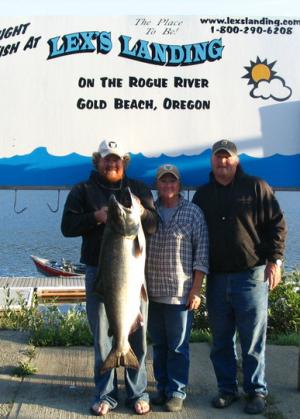Source: Fishing in Oregon: The Complete Oregon Fishing Guide (11th Edition) by Madelynne Diness Sheehan
Also see:
Best Fishing in Oregon’s Southwest Zone (North Area Rivers and Bays)
Best Fishing in Oregon’s Southwest Zone (Lakes and Reservoirs)
The Southwest Zone includes all waters draining directly to the Pacific Ocean south to the Oregon-California border, and north to and including the Umpqua River drainage. It also includes those portions of the Klamath River drainage in Jackson County.
The following are among the best fishing rivers and bays in the southern half of the Southwest Zone:
Applegate River
Fishing for hatchery steelhead (with a clipped adipose fin) and catch-and-release for wild steelhead gets going in mid-winter and peaks in March before a seasonal closure.
Fishing for wild rainbow trout is good in early season and again in late spring, but all fishing is closed from April 1 into late May. Like the steelhead, only trout with a clipped adipose fin may be kept in the river below Applegate Lake.
See: Applegate River Fishing.
Chetco River
This scenic stream flows through myrtle groves on its way to the Pacific Ocean at Brookings on Oregon’s south coast, and it packs a reputation for unusually large fall Chinook salmon and very good winter steelheading.
Chinook are available from September through December, with peak catches in October and November. Winter steelhead first show in December and peak about January, but fishing holds up through March.
Fishing for cutthroat trout is good in spring and sea-run cutthroat (also known as a “searun” or “blueback”) return in late summer.
See: Chetco River Fishing.
Elk River
Large wild winter steelhead and late-arriving Chinook salmon are the most popular fisheries for this small river entering the Pacific just north of Port Orford.
The fall Chinook, including a popular hatchery run, often can’t get into the river until heavy rains breach the sand dune that forms at the mouth during the summer. This often occurs in October, and river fishing typically peaks in November and holds up well through December and possibly January.
Early on, before the fish get upstream, there is a unique surf fishery for Chinook on the beach about a mile south from Cape Blanco State Park. For wild steelhead – which can be kept with a conservative harvest – fishing usually peaks in January and February.
See: Elk River Fishing.
Rogue River
This famously wild and scenic river is one of Oregon’s top producers of spring and fall Chinook, fin-clipped coho, wild and hatchery steelhead and its unusual run of athletic half-pounders (immature steelhead).
Spring Chinook peak in late April and May in the lower river and May through July in the upper river, above the former Gold Ray Dam site. Fall Chinook fishing gets going in the bay at Gold Beach in July and often improves in August.
August and September are good times to target fall Chinook farther upriver to Grants Pass and beyond. Coho fishing begins in August and peaks around October. Summer steelhead also arrive in the lower river in good numbers in July, with the best fishing in the upper sections in September and October.
Winter steelhead are caught in the greatest numbers in January and February, and in some years wild winter steelhead have been available for harvest along with fin-clipped fish from both summer and winter runs. Half-pounder steelhead come back to the river after only a short stay in the ocean.
They enter with both summer and winter runs and range up to 16 inches. They must be fin-clipped to keep and are counted in the trout bag limit.
Those looking for trout also ply the “Holy Water” section, which is a challenging year-round tailrace fishery below Lost Creek Dam popular with fly anglers chasing large rainbow trout (catch and release). Trout anglers looking for dinner often fish the upper river above Lost Creek Lake for stocked trout in the summer and early fall.
See: Rogue River Fishing.
Find fishing spots in all 36 Oregon counties
Oregon Resources
ODFW Weekly Fishing Report
ODFW Trout Stocking Schedule
Oregon Fishing Regulations
National Weather Service

